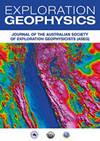利用BPNN从反射地震数据中估计有效Q参数
IF 0.8
4区 地球科学
Q4 GEOCHEMISTRY & GEOPHYSICS
引用次数: 0
摘要
地下介质的粘弹性会引起地震波的吸收和衰减,导致能量衰减和相位畸变。这种吸收和衰减通常用质量因子Q来量化。地质造成的强烈衰减效应对高分辨率成像来说是一个具有挑战性的问题。为了补偿衰减效应,有必要准确地估计衰减参数。然而,很难直接推导出非均匀衰减Q模型。这封研究信提出了一种使用反向传播神经网络(BPNN)从反射地震数据中导出Q模型的方法,BPNN是使用最广泛的神经网络模型之一。我们将Q检测问题视为模式识别任务,并训练网络将正确的Q类分配给一组输入模式。所提出的方法使用合成数据进行网络训练和验证。最后,我们使用一组模型数据和一组现场数据来证明该方法的有效性,并获得了经过适当补偿的时域高分辨率成像结果。本文章由计算机程序翻译,如有差异,请以英文原文为准。
Estimating effective Q parameters from reflection seismic data using BPNN
The viscoelasticity of an underground medium will cause absorption and attenuation of seismic waves, resulting in energy attenuation and phase distortion. This absorption and attenuation is often quantified by the quality Factor Q. The strong attenuation effect resulting from geology is a challenging problem for high-resolution imaging. To compensate for the attenuation effect, it is necessary to estimate the attenuation parameters accurately. However, it is difficult to directly derive a heterogeneous attenuation Q model. This research letter proposes a method to derive a Q model from reflection seismic data using a backpropagation neural network (BPNN), one of the most widely used neural network models. We treated the Q detection problem as a pattern recognition task and train a network to assign the correct Q classes to a set of input patterns. The proposed method uses synthetic data for network training and validation. Finally, we used a set of model data and a set of field data to demonstrate the effectiveness of this method, and the high-resolution imaging results in the time domain with appropriate compensation are obtained.
求助全文
通过发布文献求助,成功后即可免费获取论文全文。
去求助
来源期刊

Exploration Geophysics
地学-地球化学与地球物理
CiteScore
2.30
自引率
0.00%
发文量
33
审稿时长
>12 weeks
期刊介绍:
Exploration Geophysics is published on behalf of the Australian Society of Exploration Geophysicists (ASEG), Society of Exploration Geophysics of Japan (SEGJ), and Korean Society of Earth and Exploration Geophysicists (KSEG).
The journal presents significant case histories, advances in data interpretation, and theoretical developments resulting from original research in exploration and applied geophysics. Papers that may have implications for field practice in Australia, even if they report work from other continents, will be welcome. ´Exploration and applied geophysics´ will be interpreted broadly by the editors, so that geotechnical and environmental studies are by no means precluded.
Papers are expected to be of a high standard. Exploration Geophysics uses an international pool of reviewers drawn from industry and academic authorities as selected by the editorial panel.
The journal provides a common meeting ground for geophysicists active in either field studies or basic research.
 求助内容:
求助内容: 应助结果提醒方式:
应助结果提醒方式:


